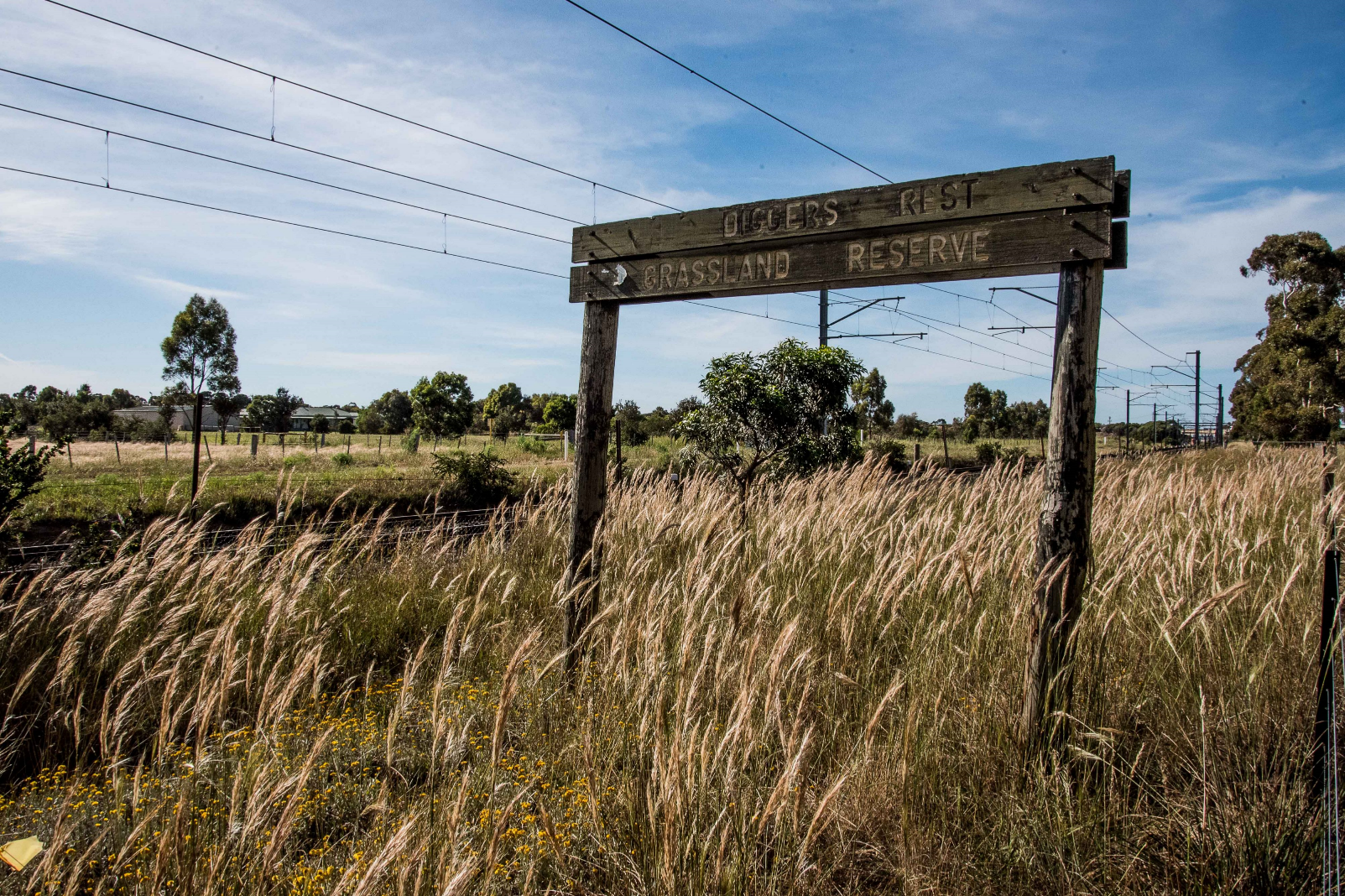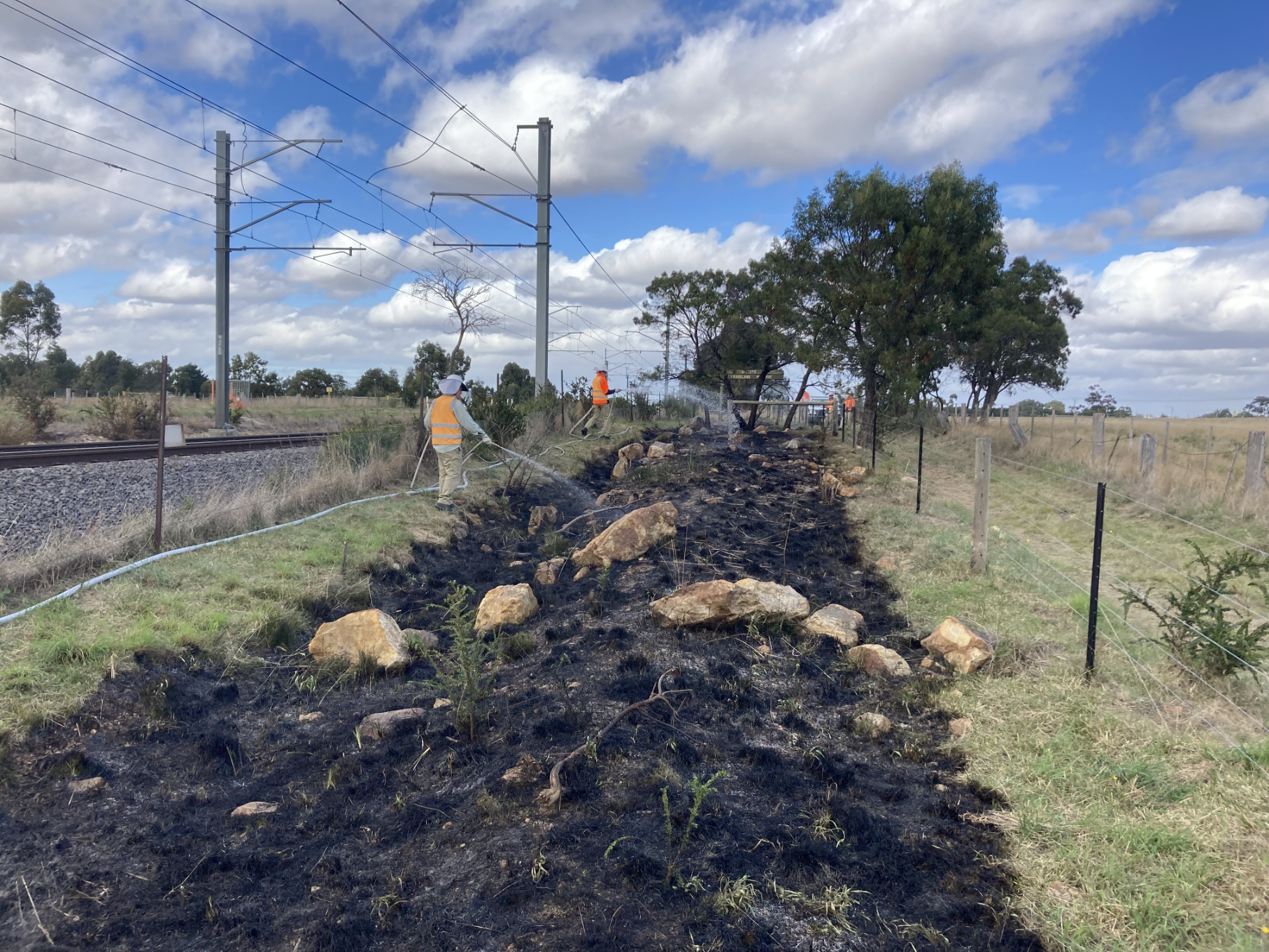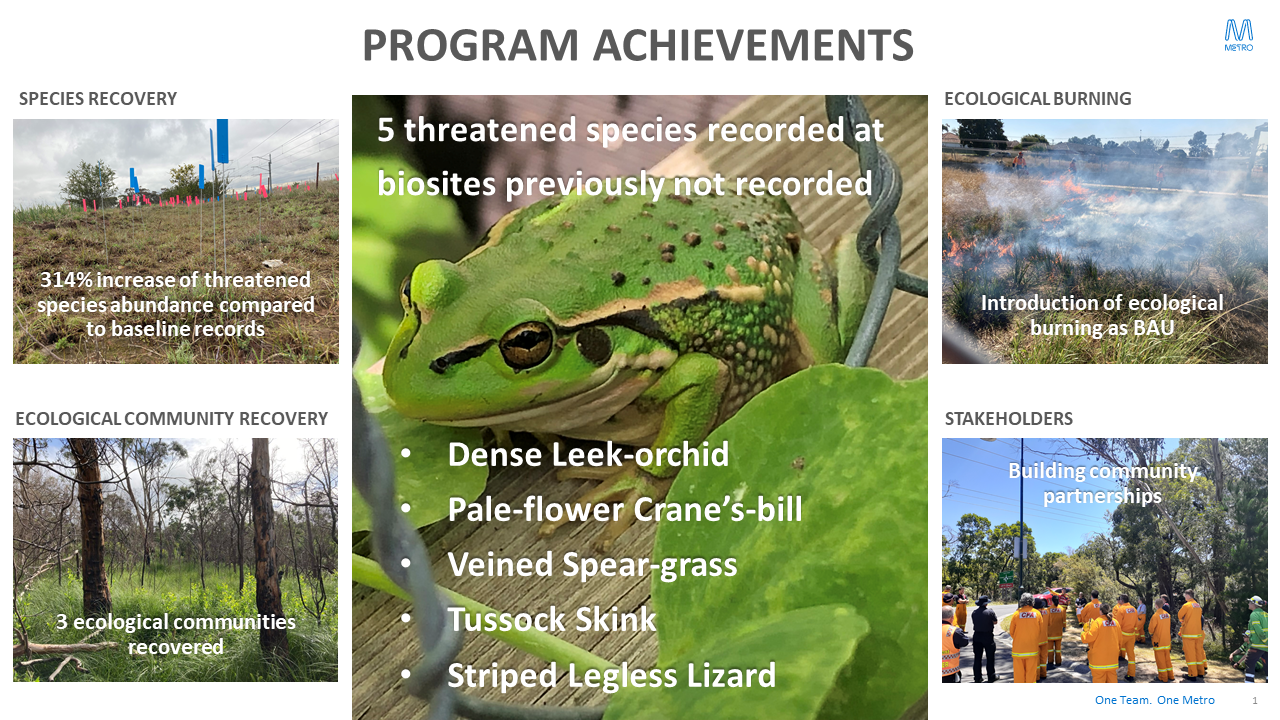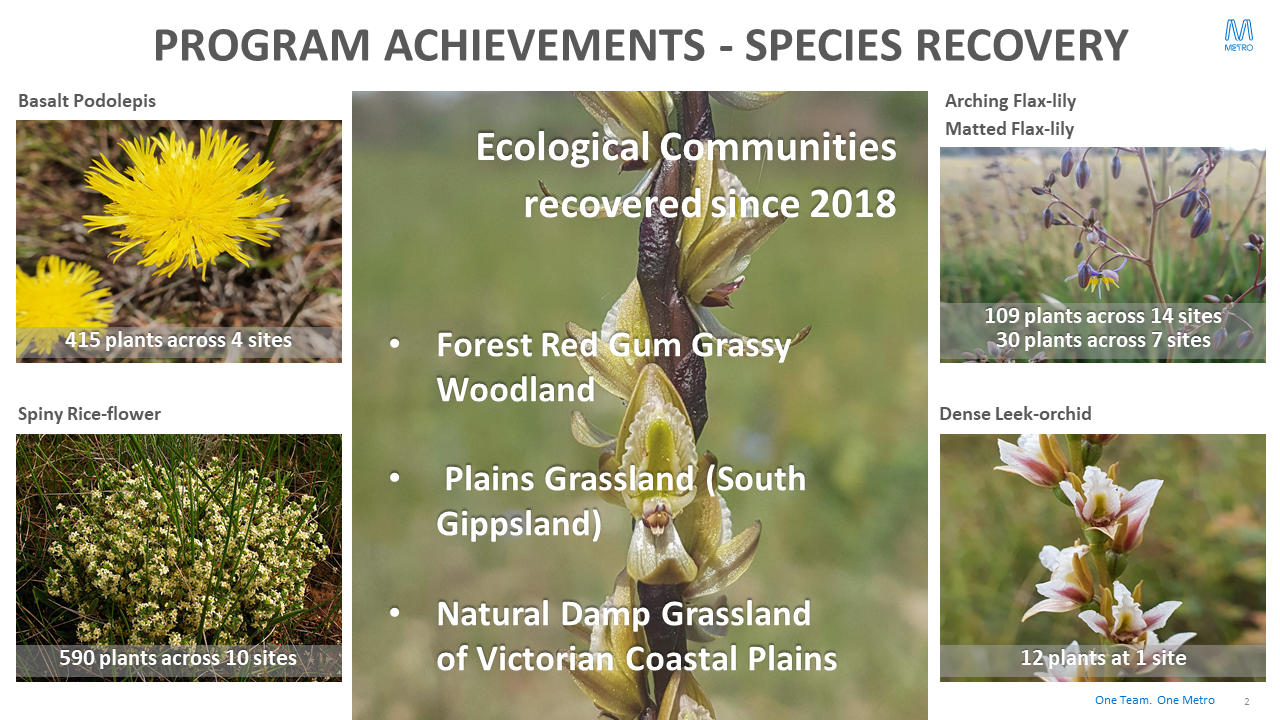Metro Trains Melbourne Biosite Management Program – Protecting and enhancing biodiversity values within an urban rail environment – Environmental Outcomes
Describe WHAT you have done and HOW you have done it.
Starting in 2018, Metro Trains Melbourne (MTM) has established an industry-leading biodiversity program that aims to restore and maintain 30 sites of biodiversity significance across the Melbourne metro network. Rail corridors have long been recognised as ideal biodiversity preservation sites. This concept is acknowledged across Australia, but nowhere else is this more applicable than the MTM network. The MTM network not only retains some of Australia’s most poorly represented habitat types and threatened species, but the radial layout of MTM’s network means it plays an important function in linking up larger core areas of habitat across Greater Melbourne.
The 30 sites that Metro has committed to managing are referred to as biosites. Biosites contain threatened flora, fauna, and ecological community values and are located throughout Greater Melbourne, with a large number occurring in rail corridors. There is a long history of academic research associated with biosites in the rail corridor, and the wider community places a large amount of value in these areas. This is largely due to biosites representing some of the most natural examples of nationally threatened ecological communities and species habitats that remain and are invaluable as reference areas.
After several decades of inappropriate or limited management of biosites across Victoria, Metro completed baseline assessments to understand their condition, map their current extent and validate historical threatened flora and fauna records. Key biodiversity metrics captured during the baseline assessment were later used to measure the performance of the program and the efficacy of management activities. Once the baseline condition of the biosites was understood, a Biodiversity Management Plan was prepared to guide the delivery of the biodiversity restoration program over the MTM franchise period (7 years). Central to the management plan’s success was its ability to be adaptable to seasonal variability and management treatment success, as well as having clear site base objectives and targets.
Key management activities that MTM’s Biosite Management Program is completing across the 30 biosites includes vegetation biomass (dead plant material) removal, particularly in native grassland sites where a build-up of biomass material then decomposes, releasing nutrients and favouring weed invasion and growth. Biomass management is undertaken by completing cool season ecological burns as well as mechanical methods. Other management actions undertaken includes threatened flora management such as hand weeding around threatened plants, weed control and pest animal management. Permanent protection fencing has been installed around all biosites to exclude un-authorised entry. Now in the sixth year of management, a greater emphasis is being placed on revegetating disturbed areas within biosites.
In addition to MTM’s original commitment, through working in partnership with Metro’s major project partners, an additional 30 sites of biodiversity significance containing threatened flora and fauna values have been identified across the Metro network. In FY22-23, 10 new sites considered at greatest risk or importance were brought into the wider Biosite Management Program and are currently under management. An additional nine biosites will be established in FY23-24 and nine more biosites in the following years.
What were the OUTCOMES and how were those outcomes shared?
A mid-franchise monitoring event was undertaken in 2022 to track and monitor key performance metrics for the Biosite Management Program against baseline conditions. Several monitoring methods and metrics were used to monitor the program’s performance including the Habitat Hectare method for habitat condition, as well as undertaking threatened flora surveys.
The results from the mid-franchise monitoring event far exceeded expectations including all sites recording an increased plant species richness (increased species diversity) and 11 threatened flora and fauna species recorded an increased abundance across all biosites. In addition, weed percentage of cover have reduced at all biosites which has contributing towards the achievements listed below.
Key biodiversity program outcomes to date identified through the 2022/23 monitoring event include:
- 314% increase of threatened species abundance compared to baseline records
- 3 ecological communities recovered
- 5 threatened species recorded at biosites where they were previously not recorded
- Introduction of an annual ecological burn program as a business-as-usual management activity
- Identification of 30 new biosites to be protected and managed across the Metro network, 10 of which were protected in FY22-23.
Individual species increased abundance achievements include (recorded in 2022/23):
- Spiny Rice-flower (Commonwealth - Critically Endangered) Increased abundance by 590 plants across 10 biosites
- Matted Flax-lily (Commonwealth – Endangered) Increased abundance by 109 plants across 7 biosites
- Dense Leek-orchid (Commonwealth – Vulnerable) Increased abundance by 12 plants at 1 biosite
- Large-fruit Groundsel - (Commonwealth – Vulnerable) Increased abundance by 65 plants across 6 biosites
- Basalt Podolepis (Victoria – Endangered) Increased abundance by 415 plants across 4 biosites
- Arching Flax-lily (Victoria – Critically Endangered) Increased abundance by 109 plants across 14 biosites
A key reason why the Biosite Management Program recorded these significant achievements was the establishment of an ecological burning program. When the Biodiversity Management Plan was first developed, it was considered unlikely that a plan to introduce an ecological burning program into an operating urban rail environment would be realised. However, through considerable stakeholder engagement and a risk-based approach, Metro now undertakes 8-10 cool season ecological burns annually across the Metro network.
Ecological burning provides suitable conditions to increase plant species richness by reducing competition to resources such as light and soil moisture. Ecological burns also provide environmental cues for plants to germinate and provide optimal conditions for post-burn weed control to significantly reduce weed cover.
Our ecological burns are staged and undertaken in a mosaic pattern within biosites in order to provide a refuge area for fauna species to move into to avoid flames. This also means that only manageable sized areas are tackled at any one time, particularly for resource intensive post-burn weed control efforts. Our grassland and grassy woodland biosites are generally burnt on a 3-5-year cycle which seeks to replicate the natural burning cycle of these ecosystems.
Resulting from the 10 new biosites established in FY22/23, there will be an additional 251 threatened and protected species being protected and managed. These species include Large-flower Crane's-bill, Matted Flax-lily, Pale Flax-lily, Spiny Rice-flower, Sun Orchids and Veined Spear-grass. In addition to these, the remaining 21 new biosites that will be established between FY23/24 and FY25/26 will result in an additional 79 threatened species records being protected and managed. Additional species protected to those listed above include Arching Flax-lily and Eltham Copper Butterfly.
In partnership with the Rail Infrastructure Alliance as part of the Sunbury Line Upgrade Project, MTM is able to deliver a significant biodiversity initiative that seeks to increase the area (ha) of existing biosites within the Sunbury line corridor by enhancing and connecting several fragmented biosites, primarily through the use of the direct seeding technique. This biodiversity initiative has recently been verified by the Infrastructure Sustainability Council (ISC) and will work alongside Metro’s Biosite Management Program.
To advance this initiative, Metro has entered into a research partnership with the Green Infrastructure Research Group at the University of Melbourne to develop a native grassland direct seeding research trial to determine the feasibility of different restoration approaches in an operating rail environment. We will protect, diversify and extend existing remnants by replacing damaged interiors of biosites. A key aim of the research is to secure large populations of diverse species in functioning plant communities.
Describe WHO benefited from your initiative, innovation, or approach?
As part of Metro’s Biosite Management Program, we undertake advocacy and awareness raising to increase the profile of biodiversity values and emphasise the importance of biodiversity restoration in the Metro network. We release several internal Biodiversity Month communications to Metro’s staff base of 7,000. Metro’s Biodiversity Month communication plan includes an internal article in the all-staff newsletter and a company-wide email from Metro’s Zero-Harm Director promoting the Biodiversity Month theme for that year.
In 2022/23 Metro’s Biodiversity Manager presented a webinar on Metro’s journey to establish its biodiversity program and presented on program achievements recorded in the mid-franchise review. The webinar was co-hosted by the Environment Institute Australia & New Zealand and the Ecological Consultants Association Victoria which received 108 registrations with 30% of registrations being from states other than Victoria, including 7 registrations from New Zealand. This webinar has led to an invitation for Metro to present on its Biosite Management Program at an international transport ecology conference co-hosted by the Environment Institute Australia & New Zealand and Australasian Network for Ecology & Transport in 2023. Additionally, MTM has been asked to contribute an article to the Ecological Consultants Association Victoria quarterly newsletter on its biosite management achievements.
Metro Trains Melbourne is also a key contributor to several National and Victoria based biodiversity and threatened species focus and recovery groups. These groups are tasked with creating awareness and advocating for biodiversity and threatened species recovery. Groups that MTM is an active member of include the following:
- Australasian Rail Association – Biodiversity Network
- Spiny Rice-flower Species Recovery Group
- Southern Brown Bandicoot Species Recovery Group
Many of the biosites located within the MTM network have a long history of ecological academic study associated with them, with some of the early studies dating back to 1965 at the St. Albans Biosite. There is a strong connection between the academic and land management community and these biosites, as many of are recognised as containing some of the best remaining examples, or reference sites of grassland and grassy woodland ecological communities in south-eastern Australia. Indeed, through past research, they are recognised as having contributed to the ecological restoration community’s understanding of the functional requirements of, and threats to temperate grasslands. Therefore, MTM’s commitment to maintain and restore these biosites goes towards protecting these invaluable sites for future generations to learn from and appreciate.
What LEGACY and UN SDG CONTRIBUTION was achieved?
Through MTM’s Biosite Management Program and the re-introduction of fire as a reserve maintenance technique, MTM is continuing the legacy of past ecological management that had inadvertently been fostered by rail reserve managers from the former Victorian Railways. In the era of steam locomotives regular, often annual, fuel reduction burning was undertaken across Victorian rail reserves as a bushfire mitigation technique. There are documented observations which suggest the practice of routine burning had been undertaken since the early 1900’s (SC Sutton, 1916). Research undertaken by Stuwe and Parsons (1977) determined that regular controlled burning as well as the absence of stock grazing had led to the closest approximation of the natural state of natural temperate grasslands being retained in rail reserves (Stuwe, 1986). Indeed, Stuwe noted that native grasslands within rail reserves represented the most natural examples of natural temperate grasslands and are invaluable as reference areas, and a source of seed for rare and threatened plants.
MTM is also continuing the legacy of the ecological research community by continuing to maintain the sites of biodiversity significance across the metro network. Due to the history of burning within the rail reserve, the flora and fauna assemblage of grasslands within the rail reserve have been used as reference examples of such ecosystems. This has led to a long history of academic research being undertaken within the Metro biosites which has contributed to a greater understanding of the functional requirements of such ecosystems and threatened species that exist within them, along with their management requirements and threats. Some of the earliest empirical studies on south-eastern Australian grassland ecosystems were undertaken in areas now known as biosites. This includes a PhD study by Groves in 1965 on the functional requirements of Kangaroo Grass tussock grassland at the St. Albans Biosite. Many more research studies have been completed since this time on individual threatened taxa and natural temperate grasslands across Metro’s Sunbury and Werribee rail corridors. Metro is currently collaborating with researchers from LaTrobe University’s Environment & Genetics Department to collate historical research data from the 1980’s- 2000’s from biosites on the Sunbury line to compare against annual records that Metro have been collecting as part of our biosite monitoring program. This information will indicate changes of species composition and potentially inform Metro’s restorations efforts moving forward.
MTM’s Biosite Management Program is contributing towards the UN Sustainable Development Goal 15 – conserving life on land. A key focus of Goal 15 is to protect and restore terrestrial ecosystems and to stop biodiversity loss. There are 18 Commonwealth and Victorian listed threatened flora and fauna species represented by over 1,300 individual records, and 5 ecological communities that occur within the 30 biosites across the metro network. Through this program, MTM is contributing to the ongoing conservation and preservation of these species, a key focus of the UN SDG-15. Although the land area that is covered by Metro’s 30 biosites is relatively small, these biosites represent some of the most significant areas of biodiversity and species conservation across the Greater Melbourne area, indeed Australia.
[embed]https://vimeo.com/845795632?share=copy[/embed]






